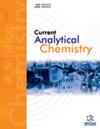Ag-TiO2 光伏协同场催化降解四环素的性能
IF 1.7
4区 化学
Q3 CHEMISTRY, ANALYTICAL
引用次数: 0
摘要
背景:背景:四环素(TC)是一种常用的抗生素,被广泛用于医疗行业,导致每年有大量的四环素污水排放到水系统中,对人类健康和环境造成危害:四环素(TC)是一种常用的抗生素,被广泛用于医疗行业,导致每年有大量的四环素污水排放到水系统中。这对人类健康和环境都造成了损害。目标:为解决光生载体络合和光催化剂固定化问题,我们开发了一种新型技术。与传统的光催化光电电极相比,光电协同领域使用的悬浮催化剂更加稳定,并增加了催化剂与污染物之间的固液接触面积。 目标:本文利用溶胶-凝胶制备的掺银二氧化钛材料对 TC 进行光电催化降解。方法:本文利用溶胶-凝胶制备的掺银二氧化钛材料对 TC 进行光电协同场催化降解。研究考察了 Ag 掺杂比例、煅烧条件、催化剂注入、pH 值、电解质和电解质注入对光电协同场催化降解的影响。实验在光电复合场中进行,采用 50 mA 恒定电流和 357 nm 紫外灯,持续 60 分钟。使用 XRD、TEM 和 XPS 技术对复合材料进行了表征:研究考察了 Ag 掺杂比例、煅烧条件、催化剂注入、pH 值、电解质和电解质注入如何影响光电催化活性。实验在光复合材料场中进行,恒定电流为 50 毫安,357 纳米紫外灯照射 60 分钟。使用 XRD、TEM 和 XPS 技术对复合材料进行了表征。结果Ag-TiO2 光电协同场催化反应在 357 纳米紫外灯照射 60 分钟和 50 毫安恒定电流的条件下降解了 5 毫克/升四氯化碳,掺杂摩尔比为 Ti:Ag=100:0.光电协同场催化降解过程对 5 mg/L TC 的降解率达到 90.49%,超过了电催化和光催化的综合降解率。淬灭实验表明,在没有淬灭剂的情况下,TC 的降解率从 90.49% 下降到 53.23%、42.58% 和 74.52%。与 h+ 和 -O2- 相比,-OH 的存在影响更大。结论研究结果表明,Ag-TiO2 能显著提高光电协同场催化降解的效果,可用于处理高浓度和低浓度 TC。这为使用基于钛的光电催化材料处理有机废水确立了基准:在钛: 银摩尔掺杂比为 100:0.5、焙烧温度为 500 ℃、焙烧时间为 2 h 的制备条件下,Ag-TiO2 光电催化反应在 357 nm 紫外灯照射 60 min 和恒定电流(50 mA)下降解了 5 mg/L 的 TC。淬灭实验表明,在没有淬灭剂的情况下,TC 的降解率从 90.49% 下降到 53.23%、42.58% 和 74.52%。与 h+ 和 -O2- 相比,-OH 的存在影响更大。本文章由计算机程序翻译,如有差异,请以英文原文为准。
Ag-TiO2 Photovoltaic Synergistic Field-catalyzed Degradation Performance of Tetracycline
Background: Tetracycline (TC), a commonly used antibiotic, is extensively utilized in the medical sector, leading to a significant annual discharge of tetracycline effluent into the water system, which harms both human health and the environment. background: Tetracycline (TC), a commonly used antibiotic, is extensively utilized in the medical sector, leading to a significant annual discharge of tetracycline effluent into the water system. This harms both human health and the environment. Objective: A novel technique was developed to address the issues of photogenerated carrier complexation and photocatalyst immobilization. Compared to traditional photocatalytic photoelectrodes, the suspended catalyst used in the photovoltaic synergy field is more stable and increases the solidliquid contact area between the catalyst and the pollutant. objective: This paper uses sol-gel-prepared Ag-doped-TiO2 materials for the photoelectrocatalytic degradation of TC. Methods: This paper uses sol-gel-prepared Ag-doped-TiO2 materials for the photoelectric synergistic field-catalyzed degradation of TC. The study examined how the Ag doping ratio, calcination conditions, catalyst injection, pH, electrolytes, and electrolyte injection affected photoelectric synergistic field-catalyzed degradation. The experiments were performed in a photocomposite field with a constant 50 mA current and a 357 nm UV lamp for 60 minutes. The composites underwent characterization using XRD, TEM, and XPS techniques. method: The study examined how the Ag doping ratio, calcination conditions, catalyst injection, pH, electrolytes, and electrolyte injection affected photoelectrocatalytic activity. The experiments were done in a photocomposite field with a constant 50 mA current and a 357 nm UV lamp for 60 minutes. The composites underwent characterization using XRD, TEM, and XPS techniques. Results: Ag-TiO2 photoelectric synergistic field-catalyzed reaction with 357 nm ultraviolet lamp irradiation for 60 min and a constant current of 50 mA degraded 5 mg/LTC under preparation conditions of molar doping ratio of Ti: Ag=100:0.5, roasting temperature of 500 °C, and roasting time of 2 h. The photoelectric synergistic field-catalyzed degradation process achieved a degradation rate of 90.49% for 5 mg/L TC, surpassing the combined degradation rates of electrocatalysis and photocatalysis. The quenching experiments demonstrated that the degradation rate of TC decreased from 90.49% in the absence of a quencher to 53.23%, 42.58%, and 74.52%. The presence of •OH had a more significant impact than h+ and •O2-. Conclusion: The findings suggest that Ag-TiO2 significantly enhanced the efficacy of photoelectric synergistic field-catalyzed degradation and can be employed to treat high-saline and lowconcentration TC. This establishes a benchmark for using photoelectrocatalytic materials based on titanium in treating organic wastewater. result: Ag-TiO2 photoelectrocatalytic reaction with 357 nm ultraviolet lamp irradiation for 60 min and constant current (50 mA) degraded 5 mg/LTC under preparation conditions of molar doping ratio of Ti: Ag=100:0.5, roasting temperature of 500 °C, and roasting time of 2 h. The photoelectrocatalytic process achieved a degradation rate of 90.49 % for 5 mg/L TC, surpassing the combined degradation rates of electrocatalysis and photocatalysis. The quenching experiments demonstrated that the degradation rate of TC decreased from 90.49 % in the absence of a quencher to 53.23 %, 42.58 %, and 74.52 %. The presence of •OH had a more significant impact than h+ and •O2-.
求助全文
通过发布文献求助,成功后即可免费获取论文全文。
去求助
来源期刊

Current Analytical Chemistry
化学-分析化学
CiteScore
4.10
自引率
0.00%
发文量
90
审稿时长
9 months
期刊介绍:
Current Analytical Chemistry publishes full-length/mini reviews and original research articles on the most recent advances in analytical chemistry. All aspects of the field are represented, including analytical methodology, techniques, and instrumentation in both fundamental and applied research topics of interest to the broad readership of the journal. Current Analytical Chemistry strives to serve as an authoritative source of information in analytical chemistry and in related applications such as biochemical analysis, pharmaceutical research, quantitative biological imaging, novel sensors, and nanotechnology.
 求助内容:
求助内容: 应助结果提醒方式:
应助结果提醒方式:


